Army of the Ming dynasty
| Military of the Ming dynasty | |
|---|---|
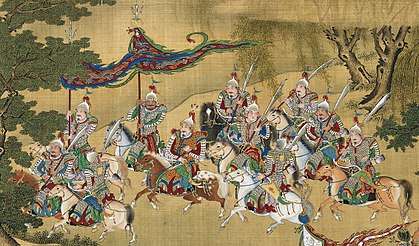 Ming cavalry, as depicted in the Departure Herald | |
| Active | 1368–1662 |
| Allegiance | Empire of the Great Ming (China) |
| Size | c. 845,000 |
| Commanders | |
| Notable commanders |
Hongwu Emperor Mu Ying Yongle Emperor Qi Jiguang Yuan Chonghuan |
The army of the Ming dynasty was the primary military apparatus of China. It was founded in 1368 during the Red Turban Rebellion by the Ming founder Zhu Yuanzhang. The system of soldiery was largely hereditary and soldiers were meant to be self sufficient. They were grouped into guards (wei) and battalions (suo), otherwise known as the wei-suo system. The guard battalion system went into decline around 1450 and was discarded in favor of mercenaries a century later.
Guard battalion system
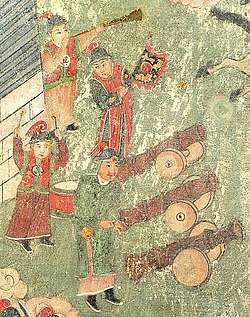
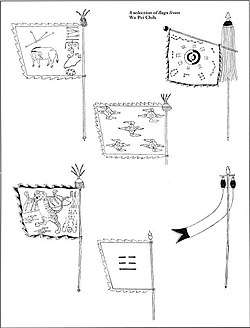

The Ming founder Zhu Yuanzhang set up a system of soldiery that was largely hereditary. Hereditary soldiers were meant to be self sufficient. They provided their own food via military farms (tun tian) and rotated into training and military posts such as the capital, where specialized drilling with firearms was provided.[1]
These hereditary soldiers were grouped into guards (wei) and battalions (suo), otherwise known as the wei-suo system. A guard consisted of 5,600 men, each guard was divided into battalions of 1,120 men (qiānhù), each battalion contained 10 companies of 112 men (bǎihù), each company contained two platoons of 56 men (zǒngqí), and each platoon contained five squads of 11 or 12 men (xiǎoqí).[1]
The guard battalion system went into decline from 1450 to 1550 and the military capacity of hereditary soldiers declined substantially due to corruption and mismanagement. Some officers used their soldiers as construction gangs, some were too oppressive, others were too old and unfit for service, and many did not observe the proper rotational drilling schedule. In the 16th century official registers listed three million hereditary soldiers, but contemporary observers noted that the actual number of troops was around 845,000, and of that only about 30,000 cavalry.[2]
Navy
The navy was not a separate entity during the Ming era and was part of the guard battalion system. Every coastal guard battalion was allotted 50 ships for maritime defense. The Ming also set up naval palisades, beacon towers, strategic forts, and irregular military units and warships.[3] Unfortunately these defensive measures proved largely inadequate against pirate raids, and conditions continued to deteriorate until the Jiajing wokou raids were ended by Qi Jiguang and Yu Dayou.[4] Shaolin monks also took part in anti-piracy campaigns, most notably between 21 and 31 July 1553 at Wengjiagang, when a group of 120 monks exterminated over 100 pirates with only 4 monks dead.[5]
Ming naval activity was noticeably subdued. Its founder, the Hongwu Emperor, emphasized that "not even a plank is to be allowed into the sea."[4] With the exception of a brief period of maritime activity during the treasure voyages under the Yongle Emperor, the official policy towards naval expansion swayed between active restriction to ambivalence.[4] Despite this, a large number of military treatises, including extensive discussions of naval warfare, were written during the Ming period, including the Wubei Zhi and Jixiao Xinshu.[6] Additionally, shipwrecks have been excavated in the South China Sea, including wrecks of Chinese trade and war ships that sank around 1377 and 1645.[7]
Mercenaries
After the decline of the guard battalion system, the Ming army came to rely more upon mercenaries to improve efficiency and lighten local military burdens.[8]
By the 1570s, the Ming army had largely transitioned to a mercenary force.[9][1]
Command structure
The guard battalions outside the capital were placed under local provincial military commanders. Those in Beijing were placed under the joint command of the Ministry for War and five grand military commanders, which reflected the separation of power and command. The Ministry issued orders to be carried out by the commanders. [3]
Some officers were recruited through the military version of the imperial examinations, which emphasized horse archery, but not enough to impose a quality standard. These exams did however produce a few notable individuals such as Qi Jiguang and Yu Dayou.[9]
Social status
Soldiering was one of the lowest professions in the Ming dynasty. Military officers were not only subordinate to civil officials, but generals and soldiers alike were degraded, treated with fear, suspicion, and distaste. Military service enjoyed far less prestige than its civil counterpart, partly due to its hereditary status, but also because many of its members were illiterate.[8]
| Dynasty | Primary type of soldiery | Social status |
|---|---|---|
| Qin | Conscription | High |
| Han | Conscription | Mixed |
| Three Kingdoms | Volunteer | Mixed |
| Jin | Hereditary occupation | High |
| Sui | Conscription | Mixed |
| Tang | Hereditary occupation | High |
| Song | Mercenary | Low |
| Ming | Hereditary occupation | Low |
| Ming (late) | Mercenary | Low |
| Qing | Ethnic-occupational caste | Mixed |
| Qing (late) | Conscription | Mixed |
Retinues
During the late Ming dynasty, most Ming commanders had Mongol horsemen in their retinues.[10]
Southern China
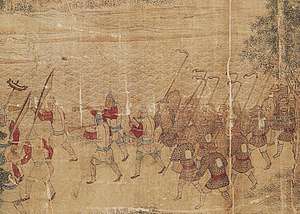
Troops of Southern Chinese extract seem to have fared better in infantry and naval combat than those in the north. They have at least on one occasion been called "ocean imps" by Northern Chinese.[11] Southerners were also intensely mistrusted by Northern Chinese. During the Wuqiao Mutiny of 1633, the northern Chinese rebels purged the "southerners" in their midst, who were suspected of aiding the Ming.[12]
Guangxi
The Ming dynasty sometimes employed "martial minorities" such as the "wolf troops" of Guangxi as shock infantry.[13]
Northern China
Qi Jiguang described northern soldiers as stupid and impatient. When he tried to introduce muskets in the north, the soldiers there were adamant in continuing to use fire lances.[14]
Liaodong
Recruits from Liaodong, and people from Liaodong in general, were considered untrustworthy, unruly, and little better than thugs.[15]
Weapons
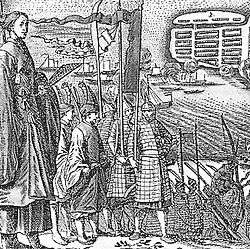
The spear was the most common weapon and soldiers were given comprehensive training in spear combat, both as individuals and in formation. A complete spear regimen lasted one hundred days.[16]
The dao, also called a saber, is a Chinese category for single edged, curved swords. It was the basic close fighting weapon of the Ming dynasty.[17] The jian, also known as a long sword, is a Chinese category for straight double-edged swords. It experienced a resurgence during the Yuan dynasty but fell out of favor again in the Ming. The jian remained in use by a small number of arms specialists but was otherwise known for its qualities as a marker of scholarly refinement.[18]
The "Horse Beheading Dao" was described in Ming sources as a 96 cm blade attached to a 128 cm shaft, essentially a glaive weapon. It's speculated that the Swede Frederick Coyett was talking about this weapon when he described Zheng Chenggong's troops wielding "with both hands a formidable battle-sword fixed to a stick half the length of a man".[19]
Some were armed with bows and arrows hanging down their backs ; others had nothing save a shield on the left arm and a good sword in the right hand ; while many wielded with both hands a formidable battle-sword fixed to a stick half the length of a man. Everyone was protected over the upper part of the body with a coat of iron scales, fitting below one another like the slates of a roof; the arms and legs being left bare. This afforded complete protection from rifle bullets (mistranslation-should read "small arms") and yet left ample freedom to move, as those coats only reached down to the knees and were very flexible at all the joints. The archers formed Koxinga's best troops, and much depended on them, for even at a distance they contrived to handle their weapons with so great skill that they very nearly eclipsed the riflemen. The shield bearers were used instead of cavalry. Every tenth man of them is a leader, who takes charge of, and presses his men on, to force themselves into the ranks of the enemy. With bent heads and their bodies hidden behind the shields, they try to break through the opposing ranks with such fury and dauntless courage as if each one had still a spare body left at home. They continually press onwards, notwithstanding many are shot down ; not stopping to consider, but ever rushing forward like mad dogs, not even looking round to see whether they are followed by their comrades or not. Those with the sword-sticks—called soapknives by the Hollanders—render the same service as our lancers in preventing all breaking through of the enemy, and in this way establishing perfect order in the ranks ; but when the enemy has been thrown into disorder, the Sword-bearers follow this up with fearful massacre amongst the fugitives.[20]
— Frederick Coyett
Qi Jiguang deployed his soldiers in a 12-man 'mandarin duck' formation, which consisted of four pikemen, two men carrying daos with a great and small shield, two 'wolf brush' wielders, a rearguard officer, and a porter.[21]
Archery with bow and crossbow was considered a central skill despite the rise of gunpowder weapons.[9]
Armour
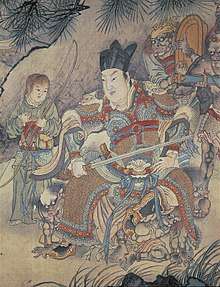

During the Ming dynasty, most soldiers did not wear armour, which was reserved for officers and a small portion of the several hundred thousand strong army.[22] Horse armour was only used for a small portion of cavalry, which was itself a minute portion of the Ming army.[23]
Brigandine armour was introduced during the Ming era and consisted of riveted plates covered with fabric.[23]
Partial plate armour in the form of a cuirass sewn together with fabric is mentioned in the Wubei Yaolue, 1638. It's not known how common plate armour was during the Ming dynasty, and no other source mentions it.[24]
Although armour never lost all meaning during the Ming dynasty, it became less and less important as the power of firearms became apparent. It was already acknowledged by the early Ming artillery officer Jiao Yu that guns "were found to behave like flying dragons, able to penetrate layers of armor."[25] Fully armoured soldiers could and were killed by guns. The Ming Marshall Cai was one such victim. An account from the enemy side states, "Our troops used fire tubes to shoot and fell him, and the great army quickly lifted him and carried him back to his fortifications."[26] It's possible that Chinese armour had some success in blocking musket balls later on during the Ming dynasty. According to the Japanese, during the Battle of Jiksan, the Chinese wore armour and used shields that were at least partially bulletproof.[27] Frederick Coyett later described Ming lamellar armour as providing complete protection from "small arms", although this is sometimes mistranslated as "rifle bullets".[20] English literature in the early 19th century also mentions Chinese rattan shields that were "almost musket proof",[28] however another English source in the late 19th century states that they did nothing to protect their users during an advance on a Muslim stronghold, in which they were all invariably shot to death.[29]
Some were armed with bows and arrows hanging down their backs ; others had nothing save a shield on the left arm and a good sword in the right hand ; while many wielded with both hands a formidable battle-sword fixed to a stick half the length of a man. Everyone was protected over the upper part of the body with a coat of iron scales, fitting below one another like the slates of a roof; the arms and legs being left bare. This afforded complete protection from rifle bullets (mistranslation-should read "small arms") and yet left ample freedom to move, as those coats only reached down to the knees and were very flexible at all the joints. The archers formed Koxinga's best troops, and much depended on them, for even at a distance they contrived to handle their weapons with so great skill that they very nearly eclipsed the riflemen. The shield bearers were used instead of cavalry. Every tenth man of them is a leader, who takes charge of, and presses his men on, to force themselves into the ranks of the enemy. With bent heads and their bodies hidden behind the shields, they try to break through the opposing ranks with such fury and dauntless courage as if each one had still a spare body left at home. They continually press onwards, notwithstanding many are shot down ; not stopping to consider, but ever rushing forward like mad dogs, not even looking round to see whether they are followed by their comrades or not. Those with the sword-sticks—called soapknives by the Hollanders—render the same service as our lancers in preventing all breaking through of the enemy, and in this way establishing perfect order in the ranks ; but when the enemy has been thrown into disorder, the Sword-bearers follow this up with fearful massacre amongst the fugitives.[20]
— Frederick Coyett
Rocket handlers often wore heavy armour for extra protection so that they could fire at close range.[30]
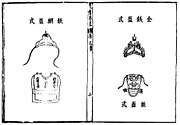 Ming helmet, breastplate, and mask from the Wubei Yaolue
Ming helmet, breastplate, and mask from the Wubei Yaolue Ming arm guards, thigh armour, and back plate from the Wubei Yaolue
Ming arm guards, thigh armour, and back plate from the Wubei Yaolue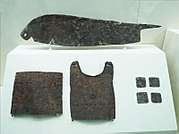 Ming breast and back plates
Ming breast and back plates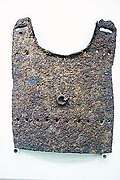 Ming breastplate
Ming breastplate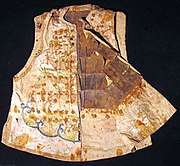 Ming brigandine
Ming brigandine Late Southern Ming lamellar armour
Late Southern Ming lamellar armour
Formations
Squad level
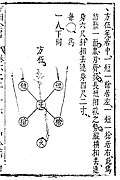 Square
Square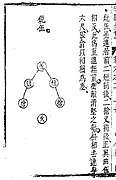 Sharp
Sharp Crooked
Crooked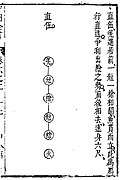 Straight
Straight One
One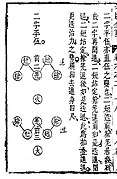 Two
Two Qi Jiguang's 'mandarin duck formation' in standby and combat.
Qi Jiguang's 'mandarin duck formation' in standby and combat.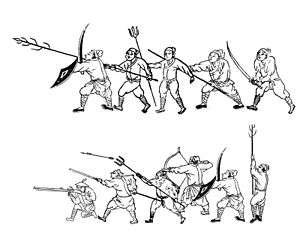 Qi Jiguang's 'new mandarin duck formation.'
Qi Jiguang's 'new mandarin duck formation.' Qi Jiguang's 'infantry squad.' A contingent of armored soldiers.
Qi Jiguang's 'infantry squad.' A contingent of armored soldiers. Qi Jiguang's 'killer squad.' The killer squad was a reconfigured Mandarin Duck formation.
Qi Jiguang's 'killer squad.' The killer squad was a reconfigured Mandarin Duck formation. Qi Jiguang's 'firearm squad.'
Qi Jiguang's 'firearm squad.'
Platoon level
 Square
Square Square and One
Square and One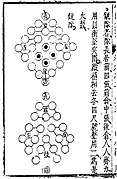 Sharp
Sharp Crooked
Crooked Straight
Straight Two
Two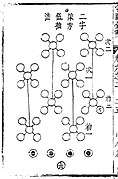 Two
Two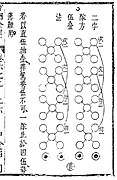 Two
Two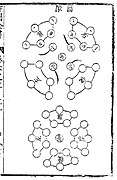 Round
Round
Company level
 Square
Square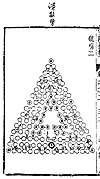 Enemy Routing
Enemy Routing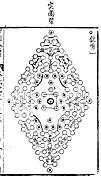 Breakout
Breakout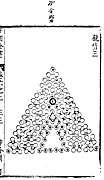 Divide and Regroup
Divide and Regroup Crooked
Crooked Straight
Straight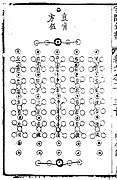 Straight Square
Straight Square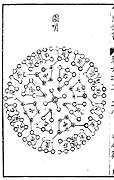 Round
Round
Battalion level
 Square
Square Sharp
Sharp Crooked
Crooked Round
Round
Encampment level
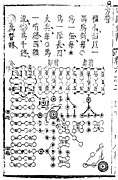 Square
Square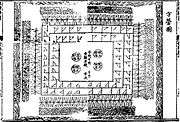 Square
Square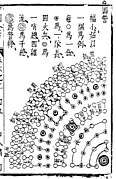 Round
Round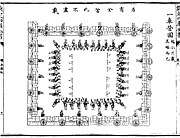 Defensive formation using carts
Defensive formation using carts
Imperial guards
Notable military figures
- Hongwu Emperor (1328-1398)
- Mu Ying (1345-1392)
- Yongle Emperor (1360-1424)
- Qi Jiguang (1528-1588)
- Yuan Chonghuan (1584-1630)
- Jiao Yu
Notes
- 1 2 3 Swope 2009, p. 19.
- ↑ Swope 2009, p. 19-20.
- 1 2 Sim 2017, p. 234.
- 1 2 3 Sim 2017, p. 236.
- ↑ Lorge 2011, p. 171.
- ↑ Papelitzky 2017, p. 130.
- ↑ Papelitzky 2017, p. 132.
- 1 2 Swope 2009, p. 21.
- 1 2 3 Lorge 2011, p. 167.
- ↑ Swope & 20009, p. 25.
- ↑ Swope 2009, p. 341.
- ↑ Swope 2014, p. 100.
- ↑ Swope 2009, p. 22.
- ↑ Andrade 2016, p. 178-179.
- ↑ Hawley 2005, p. 304.
- ↑ Lorge 2011, p. 181.
- ↑ Lorge 2011, p. 177.
- ↑ Lorge 2011, p. 180.
- ↑ Zhan Ma Dao (斬馬刀), retrieved 15 April 2018
- 1 2 3 Coyet 1975, p. 51.
- ↑ Peers 2006, p. 203-204.
- ↑ Peers 2006, p. 208.
- 1 2 Peers 2006, p. 185.
- ↑ ""Plate" armour of the Ming Dynasty". Retrieved 7 July 2018.
- ↑ Andrade 2016, p. 57.
- ↑ Andrade 2016, p. 67.
- ↑ Swope 2009, p. 248.
- ↑ Wood 1830, p. 159.
- ↑ Mesny 1896, p. 334.
- ↑ Peers 2006, p. 184.
References
- Adle, Chahryar (2003), History of Civilizations of Central Asia: Development in Contrast: from the Sixteenth to the Mid-Nineteenth Century
- Ágoston, Gábor (2005), Guns for the Sultan: Military Power and the Weapons Industry in the Ottoman Empire, Cambridge University Press, ISBN 0-521-60391-9
- Agrawal, Jai Prakash (2010), High Energy Materials: Propellants, Explosives and Pyrotechnics, Wiley-VCH
- Andrade, Tonio (2016), The Gunpowder Age: China, Military Innovation, and the Rise of the West in World History, Princeton University Press, ISBN 978-0-691-13597-7 .
- Arnold, Thomas (2001), The Renaissance at War, Cassell & Co, ISBN 0-304-35270-5
- Benton, Captain James G. (1862). A Course of Instruction in Ordnance and Gunnery (2 ed.). West Point, New York: Thomas Publications. ISBN 1-57747-079-6.
- Brown, G. I. (1998), The Big Bang: A History of Explosives, Sutton Publishing, ISBN 0-7509-1878-0 .
- Buchanan, Brenda J., ed. (2006), Gunpowder, Explosives and the State: A Technological History, Aldershot: Ashgate, ISBN 0-7546-5259-9
- Chase, Kenneth (2003), Firearms: A Global History to 1700, Cambridge University Press, ISBN 0-521-82274-2 .
- Cocroft, Wayne (2000), Dangerous Energy: The archaeology of gunpowder and military explosives manufacture, Swindon: English Heritage, ISBN 1-85074-718-0
- Cook, Haruko Taya (2000), Japan At War: An Oral History, Phoenix Press
- Cowley, Robert (1993), Experience of War, Laurel .
- Coyet, Frederic (1975), Neglected Formosa: a translation from the Dutch of Frederic Coyett's Verwaerloosde Formosa
- Cressy, David (2013), Saltpeter: The Mother of Gunpowder, Oxford University Press
- Crosby, Alfred W. (2002), Throwing Fire: Projectile Technology Through History, Cambridge University Press, ISBN 0-521-79158-8 .
- Curtis, W. S. (2014), Long Range Shooting: A Historical Perspective, WeldenOwen .
- Earl, Brian (1978), Cornish Explosives, Cornwall: The Trevithick Society, ISBN 0-904040-13-5 .
- Easton, S. C. (1952), Roger Bacon and His Search for a Universal Science: A Reconsideration of the Life and Work of Roger Bacon in the Light of His Own Stated Purposes, Basil Blackwell
- Ebrey, Patricia B. (1999), The Cambridge Illustrated History of China, Cambridge University Press, ISBN 0-521-43519-6
- Grant, R.G. (2011), Battle at Sea: 3,000 Years of Naval Warfare, DK Publishing .
- Hadden, R. Lee. 2005. "Confederate Boys and Peter Monkeys." Armchair General. January 2005. Adapted from a talk given to the Geological Society of America on March 25, 2004.
- Harding, Richard (1999), Seapower and Naval Warfare, 1650-1830, UCL Press Limited
- al-Hassan, Ahmad Y. (2001), "Potassium Nitrate in Arabic and Latin Sources", History of Science and Technology in Islam, retrieved 23 July 2007 .
- Hawley, Samuel (2005), The Imjin War, The Royal Asiatic Society, Korea Branch/UC Berkeley Press, ISBN 89-954424-2-5
- Hobson, John M. (2004), The Eastern Origins of Western Civilisation, Cambridge University Press .
- Johnson, Norman Gardner. "explosive". Encyclopædia Britannica. Chicago: Encyclopædia Britannica Online.
- Kelly, Jack (2004), Gunpowder: Alchemy, Bombards, & Pyrotechnics: The History of the Explosive that Changed the World, Basic Books, ISBN 0-465-03718-6 .
- Khan, Iqtidar Alam (1996), "Coming of Gunpowder to the Islamic World and North India: Spotlight on the Role of the Mongols", Journal of Asian History, 30: 41–5 .
- Khan, Iqtidar Alam (2004), Gunpowder and Firearms: Warfare in Medieval India, Oxford University Press
- Khan, Iqtidar Alam (2008), Historical Dictionary of Medieval India, The Scarecrow Press, Inc., ISBN 0-8108-5503-8
- Kinard, Jeff (2007), Artillery An Illustrated History of its Impact
- Konstam, Angus (2002), Renaissance War Galley 1470-1590, Osprey Publisher Ltd. .
- Liang, Jieming (2006), Chinese Siege Warfare: Mechanical Artillery & Siege Weapons of Antiquity, Singapore, Republic of Singapore: Leong Kit Meng, ISBN 981-05-5380-3
- Lidin, Olaf G. (2002), Tanegashima – The Arrival of Europe in Japan, Nordic Inst of Asian Studies, ISBN 8791114128
- Lorge, Peter A. (2008), The Asian Military Revolution: from Gunpowder to the Bomb, Cambridge University Press, ISBN 978-0-521-60954-8
- Lorge, Peter A. (2011), Chinese Martial Arts: From Antiquity to the Twenty-First Century, Cambridge: Cambridge University Press, ISBN 978-0-521-87881-4
- Lu, Gwei-Djen (1988), "The Oldest Representation of a Bombard", Technology and Culture, 29: 594–605
- May, Timothy (2012), The Mongol Conquests in World History, Reaktion Books
- McLahlan, Sean (2010), Medieval Handgonnes
- McNeill, William Hardy (1992), The Rise of the West: A History of the Human Community, University of Chicago Press .
- Mesny, William (1896), Mesny's Chinese Miscellany
- Morillo, Stephen (2008), War in World History: Society, Technology, and War from Ancient Times to the Present, Volume 1, To 1500, McGraw-Hill, ISBN 978-0-07-052584-9
- Needham, Joseph (1971), Science and Civilization in China Volume 4 Part 3, Cambridge At The University Press
- Needham, Joseph (1980), Science & Civilisation in China, 5 pt. 4, Cambridge University Press, ISBN 0-521-08573-X
- Needham, Joseph (1986), Science & Civilisation in China, V:7: The Gunpowder Epic, Cambridge University Press, ISBN 0-521-30358-3 .
- Nicolle, David (1990), The Mongol Warlords: Ghengis Khan, Kublai Khan, Hulegu, Tamerlane
- Nolan, Cathal J. (2006), The Age of Wars of Religion, 1000–1650: an Encyclopedia of Global Warfare and Civilization, Vol 1, A-K, 1, Westport & London: Greenwood Press, ISBN 0-313-33733-0
- Norris, John (2003), Early Gunpowder Artillery: 1300–1600, Marlborough: The Crowood Press .
- Papelitzky, Elke (2017), "Naval warfare of the Ming dynasty (1368-1644): A comparison between Chinese military texts and archaeological sources", in Rebecca O'Sullivan; Christina Marini; Julia Binnberg, Archaeological Approaches to Breaking Boundaries: Interaction, Integration & Division. Proceedings of the Graduate Archaeology at Oxford Conferences 2015–2016, Oxford: British Archaeological Reports, pp. 129–135 .
- Partington, J. R. (1960), A History of Greek Fire and Gunpowder, Cambridge, UK: W. Heffer & Sons .
- Partington, J. R. (1999), A History of Greek Fire and Gunpowder, Baltimore: Johns Hopkins University Press, ISBN 0-8018-5954-9
- Patrick, John Merton (1961), Artillery and warfare during the thirteenth and fourteenth centuries, Utah State University Press .
- Pauly, Roger (2004), Firearms: The Life Story of a Technology, Greenwood Publishing Group .
- Peers, C.J. (2006), Soldiers of the Dragon: Chinese Armies 1500 BC - AD 1840, Osprey Publishing Ltd
- Peers, Chris (2013), Battles of Ancient China, Pen & Sword Military
- Perrin, Noel (1979), Giving up the Gun, Japan's reversion to the Sword, 1543–1879, Boston: David R. Godine, ISBN 0-87923-773-2
- Petzal, David E. (2014), The Total Gun Manual (Canadian edition), WeldonOwen .
- Phillips, Henry Prataps (2016), The History and Chronology of Gunpowder and Gunpowder Weapons (c.1000 to 1850), Notion Press
- Purton, Peter (2010), A History of the Late Medieval Siege, 1200–1500, Boydell Press, ISBN 1-84383-449-9
- Robins, Benjamin (1742), New Principles of Gunnery
- Rose, Susan (2002), Medieval Naval Warfare 1000-1500, Routledge
- Roy, Kaushik (2015), Warfare in Pre-British India, Routledge
- Schmidtchen, Volker (1977a), "Riesengeschütze des 15. Jahrhunderts. Technische Höchstleistungen ihrer Zeit", Technikgeschichte 44 (2): 153–173 (153–157)
- Schmidtchen, Volker (1977b), "Riesengeschütze des 15. Jahrhunderts. Technische Höchstleistungen ihrer Zeit", Technikgeschichte 44 (3): 213–237 (226–228)
- Sim, Y.H. Teddy (2017), The Maritime Defense of China: Ming General Qi Jiguang and Beyond, Springer
- Swope, Kenneth M. (2009), A Dragon's Head and a Serpent's Tail: Ming China and the First Great East Asian War, 1592–1598, University of Oklahoma Press
- Swope, Kenneth (2014), The Military Collapse of China's Ming Dynasty, Routledge
- Tran, Nhung Tuyet (2006), Viêt Nam Borderless Histories, University of Wisconsin Press .
- Turnbull, Stephen (2003), Fighting Ships Far East (2: Japan and Korea Ad 612-1639, Osprey Publishing, ISBN 1-84176-478-7
- Turnbull, Stephen (2008), The Samurai Invasion of Korea 1592-98, Osprey Publishing Ltd
- Urbanski, Tadeusz (1967), Chemistry and Technology of Explosives, III, New York: Pergamon Press .
- Villalon, L. J. Andrew (2008), The Hundred Years War (part II): Different Vistas, Brill Academic Pub, ISBN 978-90-04-16821-3
- Wagner, John A. (2006), The Encyclopedia of the Hundred Years War, Westport & London: Greenwood Press, ISBN 0-313-32736-X
- Watson, Peter (2006), Ideas: A History of Thought and Invention, from Fire to Freud, Harper Perennial (2006), ISBN 0-06-093564-2
- Wilkinson, Philip (9 September 1997), Castles, Dorling Kindersley, ISBN 978-0-7894-2047-3
- Wilkinson-Latham, Robert (1975), Napoleon's Artillery, France: Osprey Publishing, ISBN 0-85045-247-3
- Willbanks, James H. (2004), Machine guns: an illustrated history of their impact, ABC-CLIO, Inc.
- Williams, Anthony G. (2000), Rapid Fire, Shrewsbury: Airlife Publishing Ltd., ISBN 1-84037-435-7
- Wood, W. W. (1830), Sketches of China
